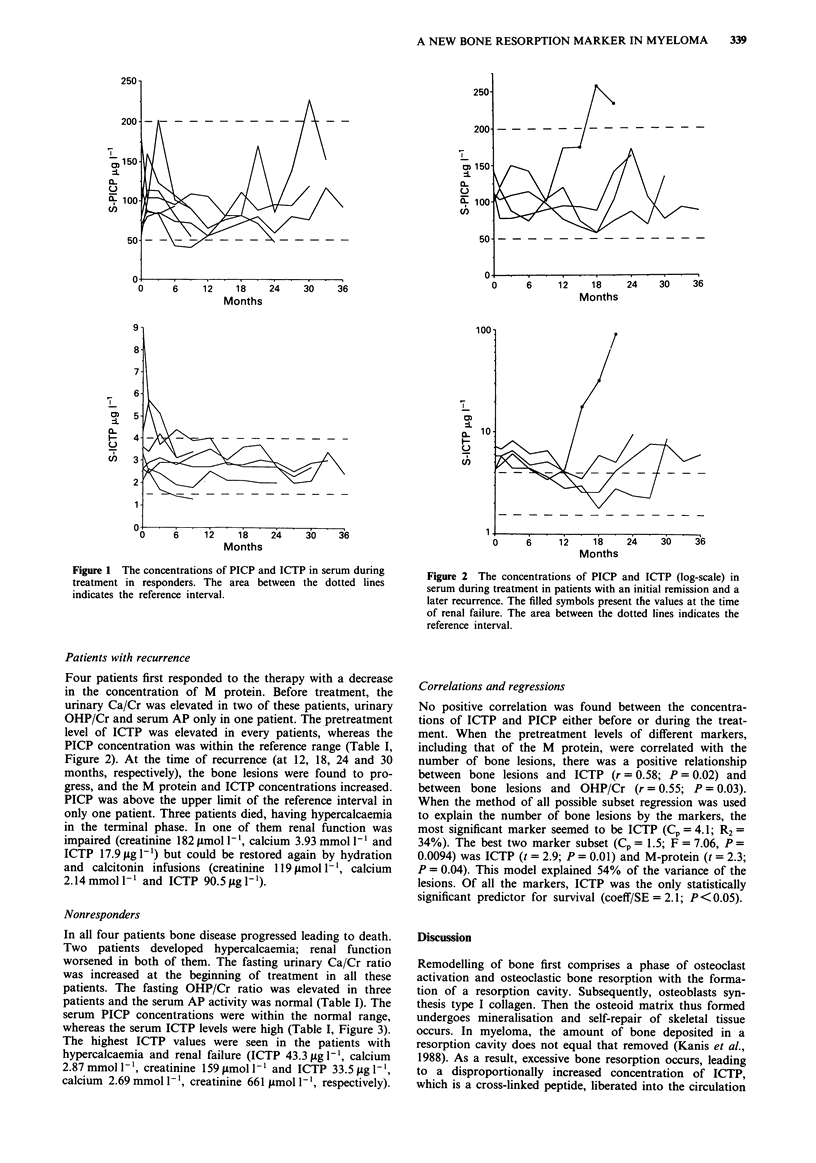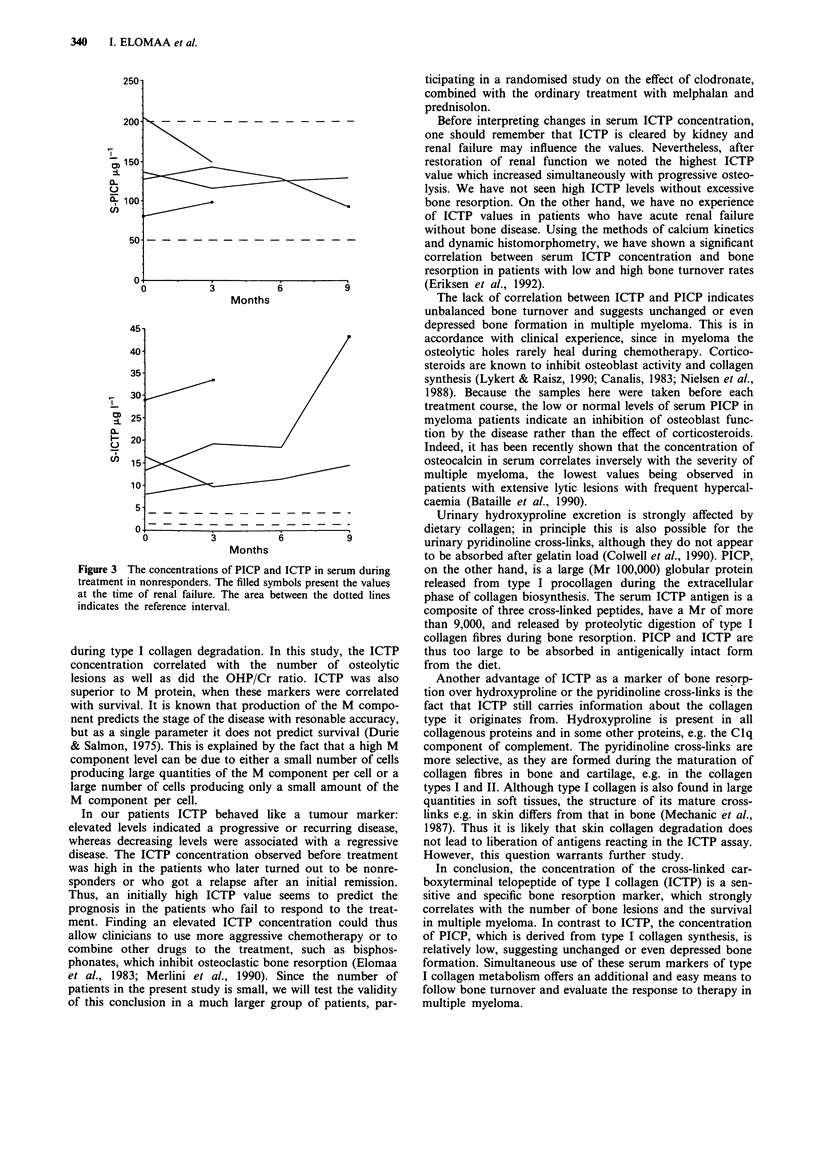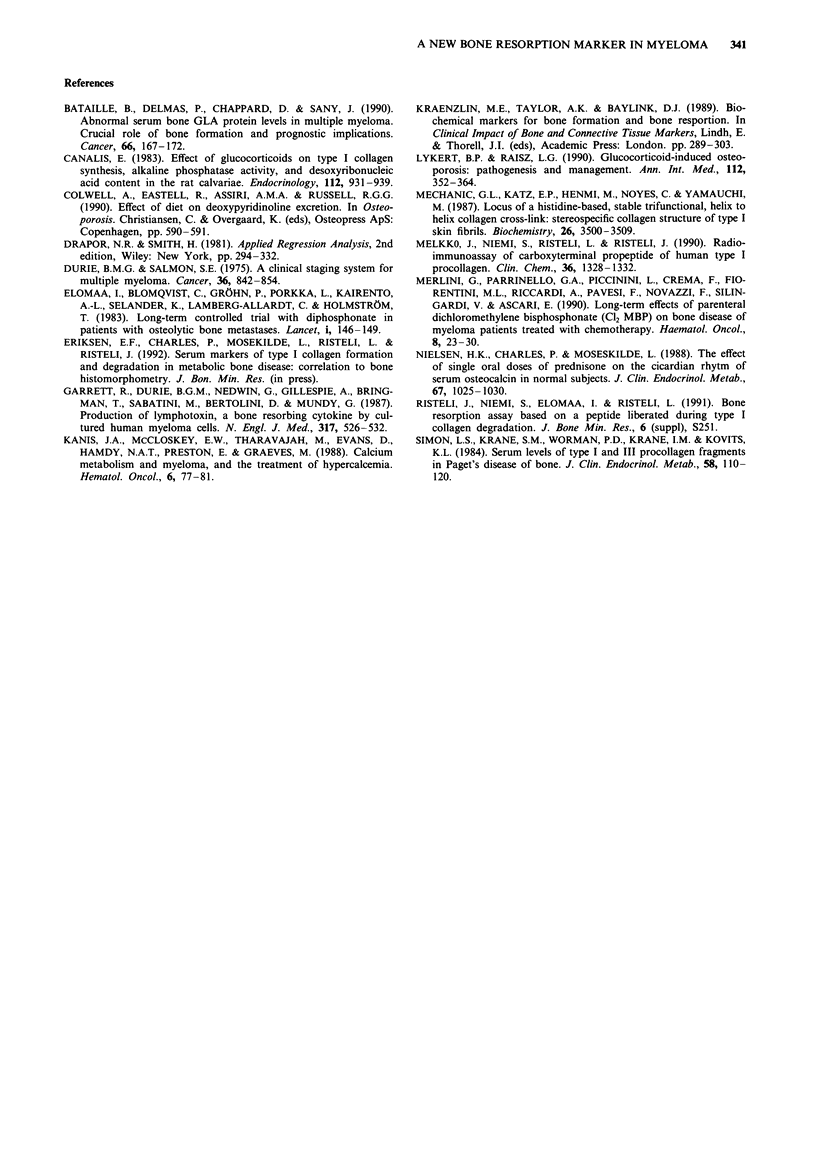Abstract
Type I collagen is the main collagen type found in mineralised bone. Specific immunoassays for PICP (carboxyterminal propeptide of type I procollagen) and ICTP (cross-linked carboxyterminal telopeptide region of type I collagen) allow simultaneous assessment of the synthesis and degradation of type I collagen in serum samples, respectively. Our aim was to find out whether these metabolites of type I collagen are useful markers for following bone turnover and evaluating treatment response in multiple myeloma, which is a good model disease of excessive osteolysis. Fifteen consecutive patients were studied before and throughout their treatment. Samples for serum PICP and ICTP were collected before starting each treatment course of melphalan and prednisolon. Response to treatment was evaluated by following the changes in M protein and bone roentgenograms. The disease was progressing in four and regressive in 11 patients, but in four of these a recurrence occurred. In nonresponders the ICTP concentration was permanently elevated despite treatment. In responders both increased or normal levels of ICTP were initially observed, but they returned to or remained in the reference interval during treatment. The ICTP concentration increased upon recurring disease. There was a strong correlation between the extent of bone lesions and ICTP. There was no correlation between ICTP and PICP, the latter mainly remaining within the reference range, a finding that suggests no change in bone formation. ICTP was a significant predictor for survival in this patient group (P less than 0.05). We conclude that ICTP is a specific and sensitive marker for bone resorption. Simultaneous use of serum ICTP and PICP offers an additional and easy means to follow bone turnover and evaluate the response to therapy in multiple myeloma.
Full text
PDF




Selected References
These references are in PubMed. This may not be the complete list of references from this article.
- Bataille R., Delmas P. D., Chappard D., Sany J. Abnormal serum bone Gla protein levels in multiple myeloma. Crucial role of bone formation and prognostic implications. Cancer. 1990 Jul 1;66(1):167–172. doi: 10.1002/1097-0142(19900701)66:1<167::aid-cncr2820660130>3.0.co;2-9. [DOI] [PubMed] [Google Scholar]
- Canalis E. Effect of glucocorticoids on type I collagen synthesis, alkaline phosphatase activity, and deoxyribonucleic acid content in cultured rat calvariae. Endocrinology. 1983 Mar;112(3):931–939. doi: 10.1210/endo-112-3-931. [DOI] [PubMed] [Google Scholar]
- Durie B. G., Salmon S. E. A clinical staging system for multiple myeloma. Correlation of measured myeloma cell mass with presenting clinical features, response to treatment, and survival. Cancer. 1975 Sep;36(3):842–854. doi: 10.1002/1097-0142(197509)36:3<842::aid-cncr2820360303>3.0.co;2-u. [DOI] [PubMed] [Google Scholar]
- Elomaa I., Blomqvist C., Gröhn P., Porkka L., Kairento A. L., Selander K., Lamberg-Allardt C., Holmström T. Long-term controlled trial with diphosphonate in patients with osteolytic bone metastases. Lancet. 1983 Jan 22;1(8317):146–149. doi: 10.1016/s0140-6736(83)92755-1. [DOI] [PubMed] [Google Scholar]
- Garrett I. R., Durie B. G., Nedwin G. E., Gillespie A., Bringman T., Sabatini M., Bertolini D. R., Mundy G. R. Production of lymphotoxin, a bone-resorbing cytokine, by cultured human myeloma cells. N Engl J Med. 1987 Aug 27;317(9):526–532. doi: 10.1056/NEJM198708273170902. [DOI] [PubMed] [Google Scholar]
- Lukert B. P., Raisz L. G. Glucocorticoid-induced osteoporosis: pathogenesis and management. Ann Intern Med. 1990 Mar 1;112(5):352–364. doi: 10.7326/0003-4819-112-5-352. [DOI] [PubMed] [Google Scholar]
- Mechanic G. L., Katz E. P., Henmi M., Noyes C., Yamauchi M. Locus of a histidine-based, stable trifunctional, helix to helix collagen cross-link: stereospecific collagen structure of type I skin fibrils. Biochemistry. 1987 Jun 16;26(12):3500–3509. doi: 10.1021/bi00386a038. [DOI] [PubMed] [Google Scholar]
- Melkko J., Niemi S., Risteli L., Risteli J. Radioimmunoassay of the carboxyterminal propeptide of human type I procollagen. Clin Chem. 1990 Jul;36(7):1328–1332. [PubMed] [Google Scholar]
- Merlini G., Parrinello G. A., Piccinini L., Crema F., Fiorentini M. L., Riccardi A., Pavesi F., Novazzi F., Silingardi V., Ascari E. Long-term effects of parenteral dichloromethylene bisphosphonate (CL2MBP) on bone disease of myeloma patients treated with chemotherapy. Hematol Oncol. 1990 Jan-Feb;8(1):23–30. doi: 10.1002/hon.2900080104. [DOI] [PubMed] [Google Scholar]
- Nielsen H. K., Charles P., Mosekilde L. The effect of single oral doses of prednisone on the circadian rhythm of serum osteocalcin in normal subjects. J Clin Endocrinol Metab. 1988 Nov;67(5):1025–1030. doi: 10.1210/jcem-67-5-1025. [DOI] [PubMed] [Google Scholar]
- Simon L. S., Krane S. M., Wortman P. D., Krane I. M., Kovitz K. L. Serum levels of type I and III procollagen fragments in Paget's disease of bone. J Clin Endocrinol Metab. 1984 Jan;58(1):110–120. doi: 10.1210/jcem-58-1-110. [DOI] [PubMed] [Google Scholar]


